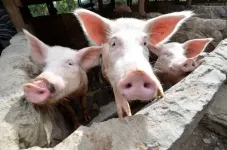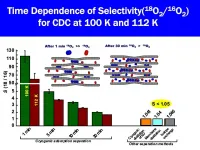(Press-News.org) New research published in Nature Food warns that heat stress in animals caused by rising temperatures and humidity will occur more frequently and for longer periods, impacting milk and meat productivity for dairy cattle, beef cattle, sheep, goat, pigs and poultry across East Africa.
Analysis of historical data from 1981-2010 shows that livestock have already been progressively subjected to heat stress conditions. According to projections, this is set to worsen significantly, with severe implications for livestock unable to cope with the extra heat.
Authors warn that 4-19% of current meat and milk production occurs in areas where dangerous heat stress conditions are likely to increase in frequency from 2071-2100. If climate conditions persist at their current accelerated rate, elevated levels of heat stress could make much of East Africa unsuitable for exotic pig, poultry and dairy cattle production unless direct and immediate action is taken.
Using limited available data and current climate projections, researchers say that dairy production is expected to be hit hardest in South Sudan, Southern parts of Eritrea, and eastern and northwestern parts of Kenya. In Uganda, heat stress conditions are already prevalent in parts of the country, requiring collective action to sustain and protect the pig sector there.
Urgent planning and investment required
Klaus Butterbach-Bahl at the International Livestock Research Institute (ILRI) and the Karlsruhe Institute of Technology, Karlsruhe (KIT), which analyzed the climate data, said: "This paper is an alarm bell for policymakers and anyone involved in livestock in the tropical region.
"In East Africa, where protein consumption is already low, this could worsen the food and nutrition security situation."
At the Alliance of Bioversity International and International Center for Tropical Agriculture,
livestock expert An Notenbaert said: "We knew that climate change would bring problems for animals, yet we were surprised about the magnitude of change.
"Climate change mitigation and adaptation measures absolutely need to be factored into decisions and strategies for livestock production."
Breed animals, enact measures to help animals cope
According to the authors, well-targeted and evidence-based climate adaptation will enable livestock production to continue and expand across East Africa. This includes identifying and making available productive animal breeds that are adapted to local conditions, particularly heat.
Countries like Rwanda and Kenya have moved towards using exotic breeds to meet the growing demand for milk in their countries. "Holstein Friesians, a popular imported breed, are not indigenous to Africa. Although they produce more milk than local breeds, they do not cope well with heat," said Notenbaert. "To make livestock production more environmentally efficient, we need breeds that can cope with rising temperatures while at the same time produce more meat and milk."
In addition to breeding, countries need to look to other mitigation strategies to increase resilience. This could be in the form of shelters or other means of shading to shield animals and ensuring sufficient water access.
"We urgently have to invest and plan now, because mitigation will have costs for farmers and donors," Notenbaert said. "We must be able to quantify economic and livelihood losses, for example through a reduction in milk yield. And we need economic, policy and livelihood measures to avoid the impacts of temperature changes."
One part of the bigger picture
ILRI livestock breeder Karen Marshall said: "Heat stress in livestock, besides being an animal welfare issue, also means less income to the farmer, less efficient use of natural resources, and higher greenhouse gas emissions per unit of livestock product.
"It is important to keep in mind, however, that while heat stress provides an important lens on the effect of climate change on animals, it is just one part of the picture."
Researchers caution that although the study only examined the direct consequences of climate change on animals, other climate change impacts, such as droughts and floods - which can impact feed production, water supply and proliferation of disease and pests - should also be taken into consideration.
INFORMATION:
The gut microbiome is an integral component of the body, but its importance in the human aging process is unclear. ISB researchers and their collaborators have identified distinct signatures in the gut microbiome that are associated with either healthy or unhealthy aging trajectories, which in turn predict survival in a population of older individuals. The work is set to be published in the journal Nature Metabolism. (Once the embargo lifts, you can access the paper here.)
The research team analyzed gut microbiome, phenotypic and clinical data from over 9,000 people - between the ages of 18 and 101 years old - across three independent cohorts. The team focused, ...
Shifting world views and putting nature at the heart of decision-making is key to achieving transformative change
COVID-19 recovery plans are an unmissable opportunity to invest in nature and reach net zero emissions by 2050
The world can transform its relationship with nature and tackle the climate, biodiversity and pollution crises together to secure a sustainable future and prevent future pandemics, according to a new report by the UN Environment Programme (UNEP) that offers a comprehensive blueprint for addressing our triple planetary emergency.
The report, ...
As obesity becomes a growing issue worldwide - nearly tripling over the last-half century - scientists are trying to gain a better understanding of the condition at the molecular level. Now, new research led by UC San Francisco scientists suggests that a single protein could play an outsize role in weight gain.
As reported in Nature Metabolism on February 18, 2021, UCSF's Davide Ruggero, PhD, and colleagues found that mice in which activity of a protein called eIF4E is diminished, either genetically or pharmaceutically, gain only half the weight of other mice, even if all the mice eat a high-fat diet.
"These mice ...
What The Study Did: Characteristics associated with posttraumatic stress disorder in patients after severe COVID-19 were analyzed in this observational study.
Authors: Delfina Janiri, M.D., of the Fondazione Policlinico Universitario Agostino Gemelli IRCCS in Rome, Italy, is the corresponding author.
To access the embargoed study: Visit our For The Media website at this link https://media.jamanetwork.com/
(10.1001/jamapsychiatry.2021.0109)
Editor's Note: The article includes conflict of interest disclosures. Please see the article for additional information, including other authors, author contributions and affiliations, financial disclosures, funding and support, etc.
INFORMATION:
Media ...
What The Study Did: This study examined how lockdowns during the COVID-19 pandemic changed the spoken communication environments of children with cochlear implants by comparing the sounds they were exposed to before and during the resulting closures of schools and nonessential businesses.
Authors: Karen A. Gordon, Ph.D., of the University of Toronto and The Hospital for Sick Children in Toronto, Canada, is the corresponding author.
To access the embargoed study: Visit our For The Media website at this link https://media.jamanetwork.com/
(doi:10.1001/jamaoto.2020.5496)
Editor's Note: The article includes conflict of interest ...
What The Study Did: This is a diagnostic study that examines the accuracy and acceptability of a 3-dimensionally printed swab for identifying SARS-CoV-2.
Authors: David M. Allen, M.D., of the National University of Singapore, is the corresponding author.
To access the embargoed study: Visit our For The Media website at this link https://media.jamanetwork.com/
(doi:10.1001/jamaoto.2020.5680)
Editor's Note: The article includes conflict of interest and funding/support disclosures. Please see the article for additional information, including other authors, author contributions and affiliations, conflict of interest and financial disclosures, and funding and support.
INFORMATION:
Media ...
Over 20.5 million years of life may have been lost due to COVID-19 globally, with an average of 16 years lost per death, according to a study published in Scientific Reports. Years of life lost (YLL) - the difference between an individual's age at death and their life expectancy - due to COVID-19 in heavily affected countries may be two to nine times higher than YLL due to average seasonal influenza.
Héctor Pifarré i Arolas, Mikko Mÿrskyla and colleagues estimated YLL due to COVID-19 using data on over 1,279,866 deaths in 81 countries, as well as life ...
Viruses are the most numerous biological entities on the planet. Now researchers at the Wellcome Sanger Institute and EMBL's European Bioinformatics Institute (EMBL-EBI) have identified over 140,000 viral species living in the human gut, more than half of which have never been seen before.
The paper, published today (18 February 2021) in Cell, contains an analysis of over 28,000 gut microbiome samples collected in different parts of the world. The number and diversity of the viruses the researchers found was surprisingly high, and the data opens up new research avenues for understanding how viruses living in the gut affect human health.
The human gut is an incredibly biodiverse environment. In addition to bacteria, hundreds of thousands of viruses ...
The incidence of surgical site infections after an operation is an important quality indicator for hospitals. An overview from six European countries published in 2017 documented increased costs and, in some cases, significantly poorer surgical outcomes due to SSIs. The European Center for Disease Control (ECDC) and authorities in the U.S. have therefore defined criteria for recording and documenting the rate of surgical site infections per procedure. Swissnoso has issued binding guidelines for Switzerland based on these criteria. The study investigated to what extent surgical site ...
Positron Emission Tomography (PET) plays a major role in the early detection of various types of cancer. A research group led by Specially Appointed Professor Katsumi Kaneko of the Research Initiative for Supra-Materials (RISM), Shinshu University have discovered a method to separate oxygen-18 from oxygen-16, an essential isotope for PET diagnosis, at high speed and high efficiency. The results of this research were recently published online in the journal Nature Communications.
The novel method for the rapid and efficient separation of O-18 from O2-16, which ...



